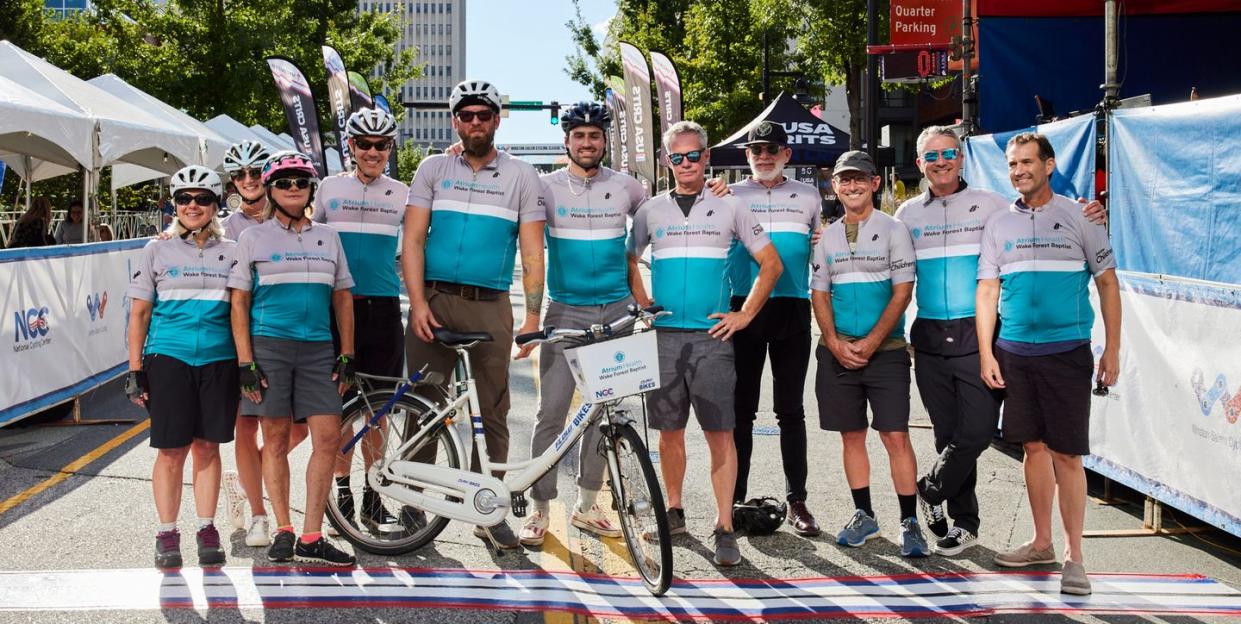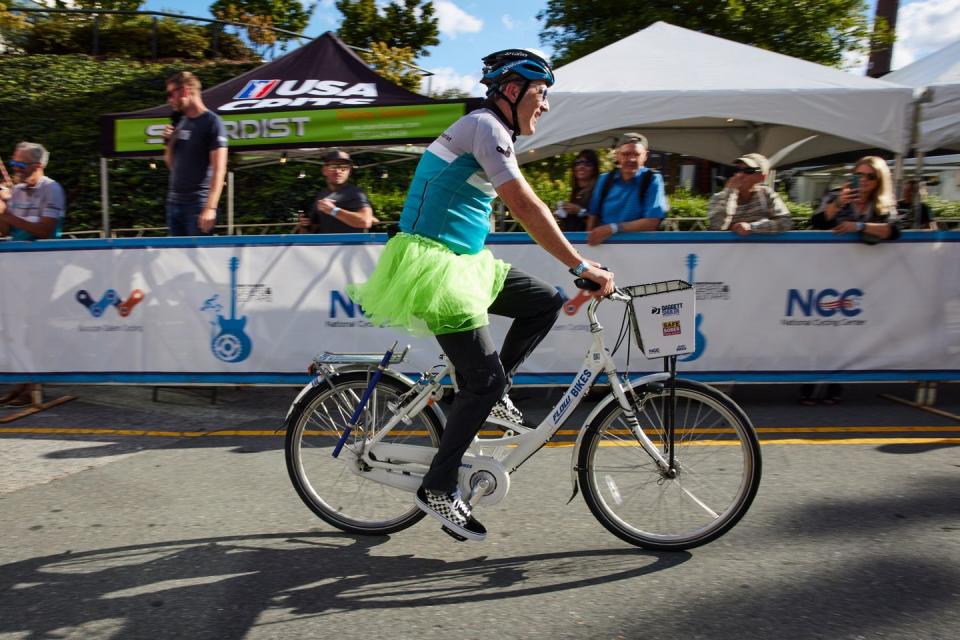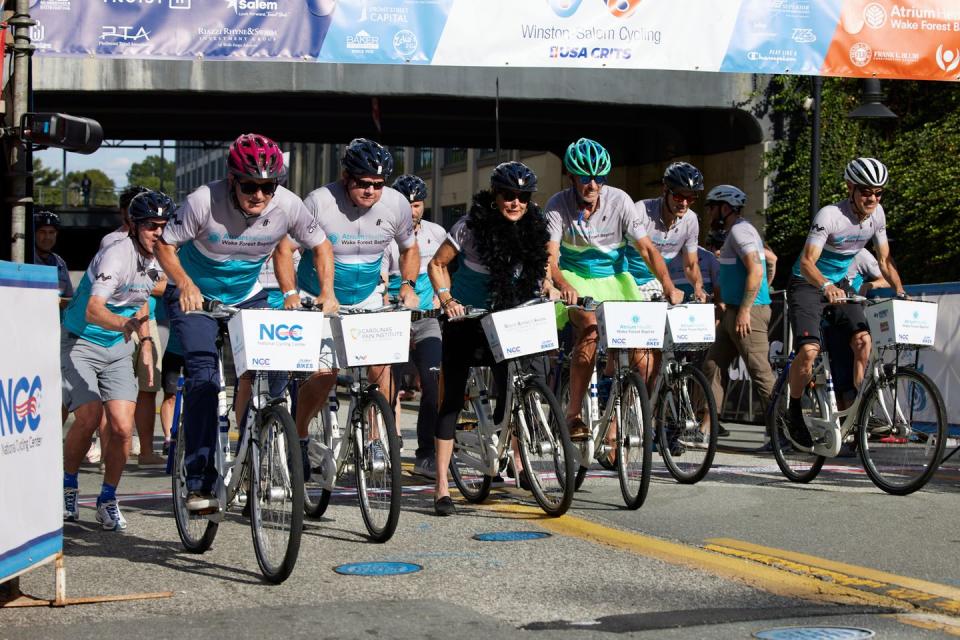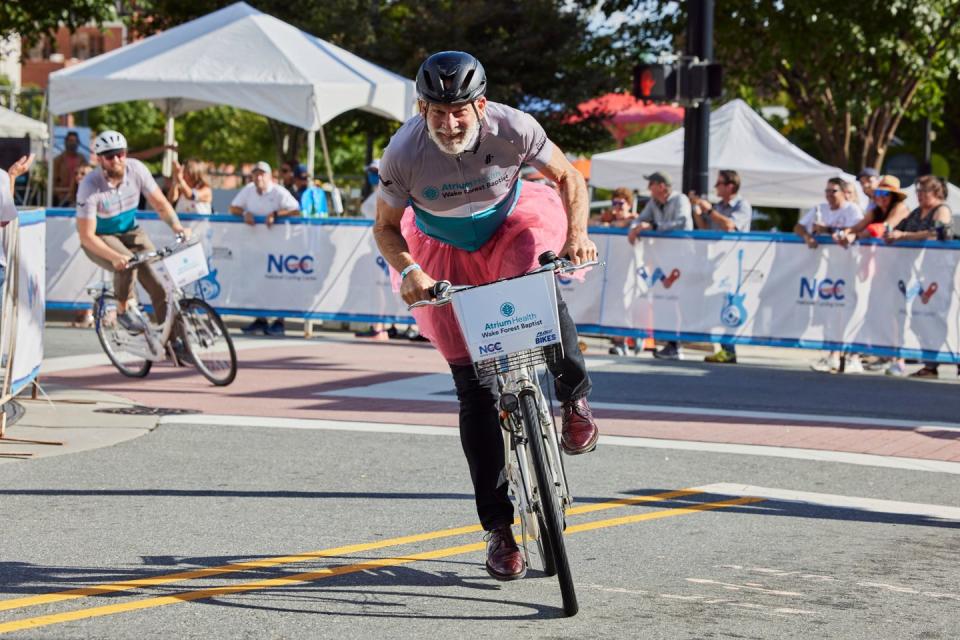Yes, the Bike Share Crit Race Is a Real Race That Happened

- Oops!Something went wrong.Please try again later.
- Oops!Something went wrong.Please try again later.
Some of the fastest bike racers in the Western Hemisphere came together on a perfect early autumn weekend for USA Crits’ season-ending race at the annual Winston-Salem Cycling Classic. Professional cyclists from teams such as L39ION of Los Angeles, DNA Pro Cycling, ATX Wolfpack, Good Guys Racing, The Butcherbox team, and Best Buddies Racing raced a tight, one-kilometer course that snaked around the hills of downtown Winston-Salem, North Carolina.
But before the pros zoomed by in a blur of high-impact yellows, neon greens, and fiery reds on their carbon fiber bikes, there would be an important score to settle:
Who could pilot a hulking, five-speed, basket-laden, steel street cruiser around the rise-and-fall-and-rise-again course fastest?
Just after the Cat 1/2s and just before the pros, there was a seven-team relay-style crit, featuring seven teams of three racers and one bike per team, had feather boas, lace tutus, a reunion of some of the members of the famed 7-Eleven race team, and plenty of laughs.
Because unlike all the other races at the Winston-Salem Classic, this crit was raced on bikeshare bikes.
The Bike Share Crit was the brainchild of Sterling Swaim, the chairman of Winston-Salem’s National Cycling Center (NCC), which is a bicycling advocacy group that aims to broaden the spectrum of opportunities for cycling while working to develop a world-class facility to train the next generation of elite American bike racers.
Swaim, a financial advisor by day and veteran bike racer, envisioned it as both a way to promote Flowbikes, the city’s bikeshare program which was unveiled six years ago, to the roughly 20,000 spectators, racers, and support staff that flock to town for the Winston-Salem Classic. Additionally, it served as a fun and unique fundraising opportunity benefiting Wake Forest Baptist Health and Atrium Health, which have long been supporters of the NCC.
“We were thinking about a way to enhance the event,” Swaim told Bicycling. “And it was right here in front of our faces. We worked so darn hard to bring the bike share back so we thought, ‘Let’s celebrate that.’”

Join Bicycling All Access for more cycling tales
At the beginning of the COVID-19 pandemic, Zagster, the bike share program’s main vender previously, went under. Rather than let it die, the NCC took the program over, partnered with regional car dealership Flow Automotive to become “Flowbikes,” and doubled their capacity to include about a hundred bikes located at twenty-two stations around town.
The bikes—which feature a durable steel-framed basket and rear gear rack, front and rear fenders, and clunky metal chain protectors—are heavy, weighing around 35 pounds.
They’re hardly built for speed, so why not race them?

Just after 5 p.m., 21 racers lined up—including me—standing three deep behind one of seven Flowbikes. Each rider would turn one lap on the course before exchanging the bike with their teammate, for three laps total. No exchange zones were set, no rules outlined. The only instruction was the classic cycling adage, reminding racers to “keep the rubber side down.”
My team was unceremoniously lined up beside the day’s ringers: former 7-Eleven pro riders Frankie Andreu, Thomas Craven, and Bob Roll. Beyond them—and former pro and noted cycling trainer, Robbie Ventura—the other racers were all average joes and janes, recreational cyclists, some weekend racers, employees of Atrium Health, the National Cycling Center, and at least one freelance writer who was there to get a story.

The digital clock hit zero and the first legs were off.
I waited at the start/finish, near the makeshift exchange zone for a few minutes until the leadoff man from first team (Andreu, Team 7-Eleven, of course) appeared around the final turn. Andreu leaped from his bike and gave Bob Roll a push into the course’s first turn.
My leadoff man appeared second, not far behind. After a wobbly bike exchange, I started a dozen lengths behind Bob Roll and headed into turn one, a righthander that led directly into the day’s biggest climb, a few hundred feet up at around seven-percent grade. That climb was hardly an issue on any of the myriad race bikes that had been zipping up it all day long, but it was steep for a thirty-pound cruiser, and my legs felt the heat immediately.
Turn two sent us into a gentle but long downhill. Roll peeked over his shoulder before pulling his elbows in tight to his torso and tucking into an aero position, trying to coax as much speed out of his Flowbike as possible. At first, I thought he was playing it up for the crowd until I realized that there was no crowd along this stretch.
Racers always race, no matter what.

I shifted into the bike’s highest gear (fifth), hammered as hard as I could, and tucked into my own aero, but by turns three and four, Roll had gapped me by a few hundred feet. I skidded into the start/finish area, and after my teammate adjusted his saddle height, I pushed him off on our team’s final lap. Team 7-Eleven was long gone, but we still had a chance to podium.
I met Roll by the race barrier, both of us breathless and smiling.
“Heavy,” he said in his unmistakable voice.
“Phew,” I said. “That first climb.”
“Yeah.”
“I almost had your wheel going into two,” I said.
The American bike racing legend laughed. No, I didn’t.
By the time Craven, the makeshift 7-Eleven team’s anchor, appeared around turn four in a solo breakaway, the race was won. Hardly a surprise. But there were still two podium places to be had.
Soon, our anchor turned the last corner, a few lengths ahead of the third-place team. But the course’s final hundred meters were a subtly brutal little uphill and we were caught, relegated to third.
Still, the lowest spot on the podium is better than not being on the podium at all.
Because even if this ridiculous (and ridiculously fun) race was a charity event aimed at raising awareness for the city’s bike share platform, racers always race, no matter what.
You Might Also Like

